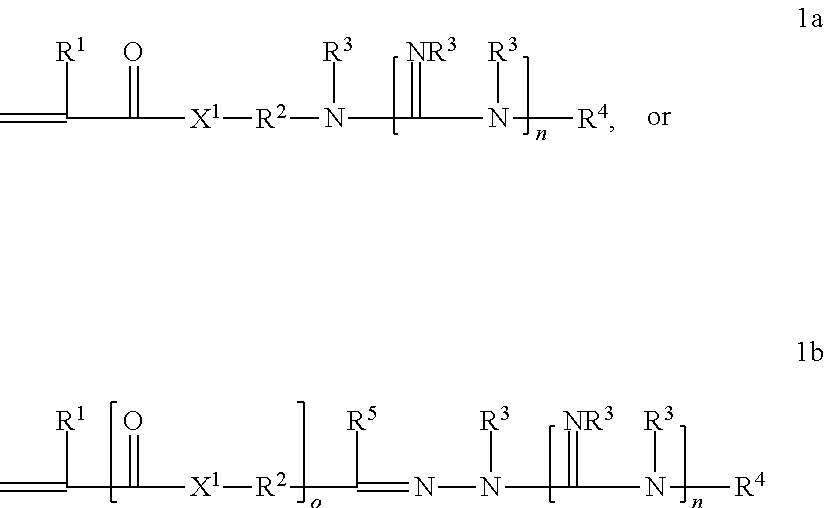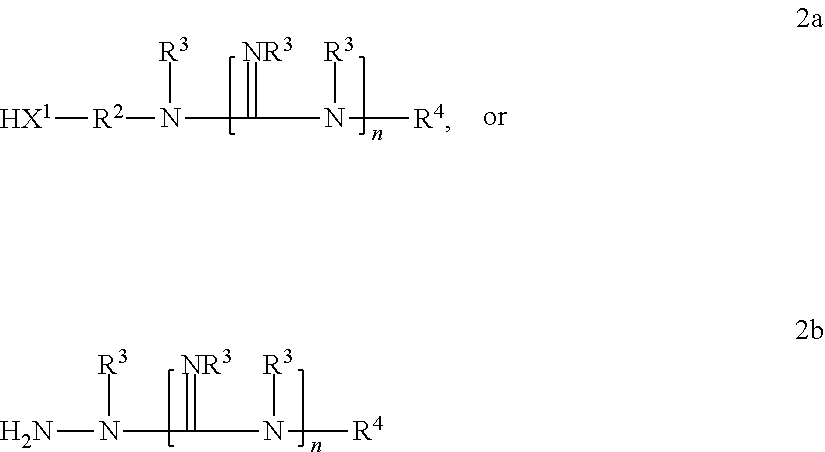Graft copolymer functionalized article
a functionalized article and graft technology, applied in the field of ligandfunctionalized substrates, can solve the problems of increasing the occurrence of problematic channeling, severe bottlenecking issues, and low throughput using this technology
- Summary
- Abstract
- Description
- Claims
- Application Information
AI Technical Summary
Benefits of technology
Problems solved by technology
Method used
Image
Examples
examples
[0119]As used herein, all ratios and percentages are by weight unless otherwise indicated. Reagents and solvents were obtained from Sigma Aldrich; St. Louis Mo., unless indicated otherwise.
Test Methods
Static BSA Capacity Method for Functionalized Substrates
[0120]Functionalized substrates were analyzed for static binding capacity by rocking one disk of the substrate in a solution of the test analyte overnight. The disk was prepared by die-punching a 24-mm diameter disk from a sheet of the substrate. Each disk was placed in a 5 mL centrifuge tube with 4.5 mL of BSA (bovine serum albumin) challenge solution (Catalog # A-7906) at a concentration of about 3.0 mg / ml in 25 millimolar TRIS (tris(hydroxymethyl)aminomethane) buffer, pH 8.0. The tubes were capped, and tumbled on a rotating mixer overnight (typically 14 hours) on a rotating mixer. The supernatant solutions were analyzed using a UV-VIS spectrometer at 279 nm (with background correction applied at 325 nm). The static binding capa...
examples 1-6
[0131]IEM-AGM sodium sulfate (4-(2-(methacryloyloxy)-ethylaminocarbonylamino)butylguanidinium sodium sulfate) was prepared according Example 99 of PCT Patent Publication Number US2012 / 024310, filed February 2012, which was based on U.S. Patent Application No. 61 / 468,302 filed Mar. 28, 2011.
[0132]Coating solutions (5 grams each) were prepared in methanol from IEM-AGM sodium sulfate, MBA, and benzophenone in the amounts listed in Table 2. To aid in formulation, a 50 mg / mL solution of MBA in methanol and a 0.5 g / mL solution of benzophenone in methanol were first prepared. Portions of these solutions were micropipetted to each coating solution to obtain the desired amount of monomer and photoinitiator in the coating solution. In Table 2, the amounts of IEM-AGM and benzophenone are listed as w / w % in the total solution, while MBA is listed as w / w % based on the amount of IEM-AGM. Primed substrates 51 were coated, grafted, and washed as described in Example 1. BSA binding capacities are s...
examples 7-13
[0133]Coating solutions were prepared in methanol from IEM-AGM, MBA, and benzophenone as described above in Example 1. Example 13 also included 4.2% w / w PEG200 methacrylate as a co-monomer. Unprimed substrates S3 were coated, grafted, and washed as described in Example 1. BSA binding capacities are shown in Table 2.
TABLE 2Exam-IEM-AGMMBABenzophenoneBSA Capacity (mg / mL)ple(w / w %)%(w / w %)StaticDynamic71422138102814211367491420.5135100101420.114271111220.511179121020.510264131420.5112102
PUM
| Property | Measurement | Unit |
|---|---|---|
| wt % | aaaaa | aaaaa |
| wt. % | aaaaa | aaaaa |
| wt. % | aaaaa | aaaaa |
Abstract
Description
Claims
Application Information
 Login to View More
Login to View More - R&D
- Intellectual Property
- Life Sciences
- Materials
- Tech Scout
- Unparalleled Data Quality
- Higher Quality Content
- 60% Fewer Hallucinations
Browse by: Latest US Patents, China's latest patents, Technical Efficacy Thesaurus, Application Domain, Technology Topic, Popular Technical Reports.
© 2025 PatSnap. All rights reserved.Legal|Privacy policy|Modern Slavery Act Transparency Statement|Sitemap|About US| Contact US: help@patsnap.com



